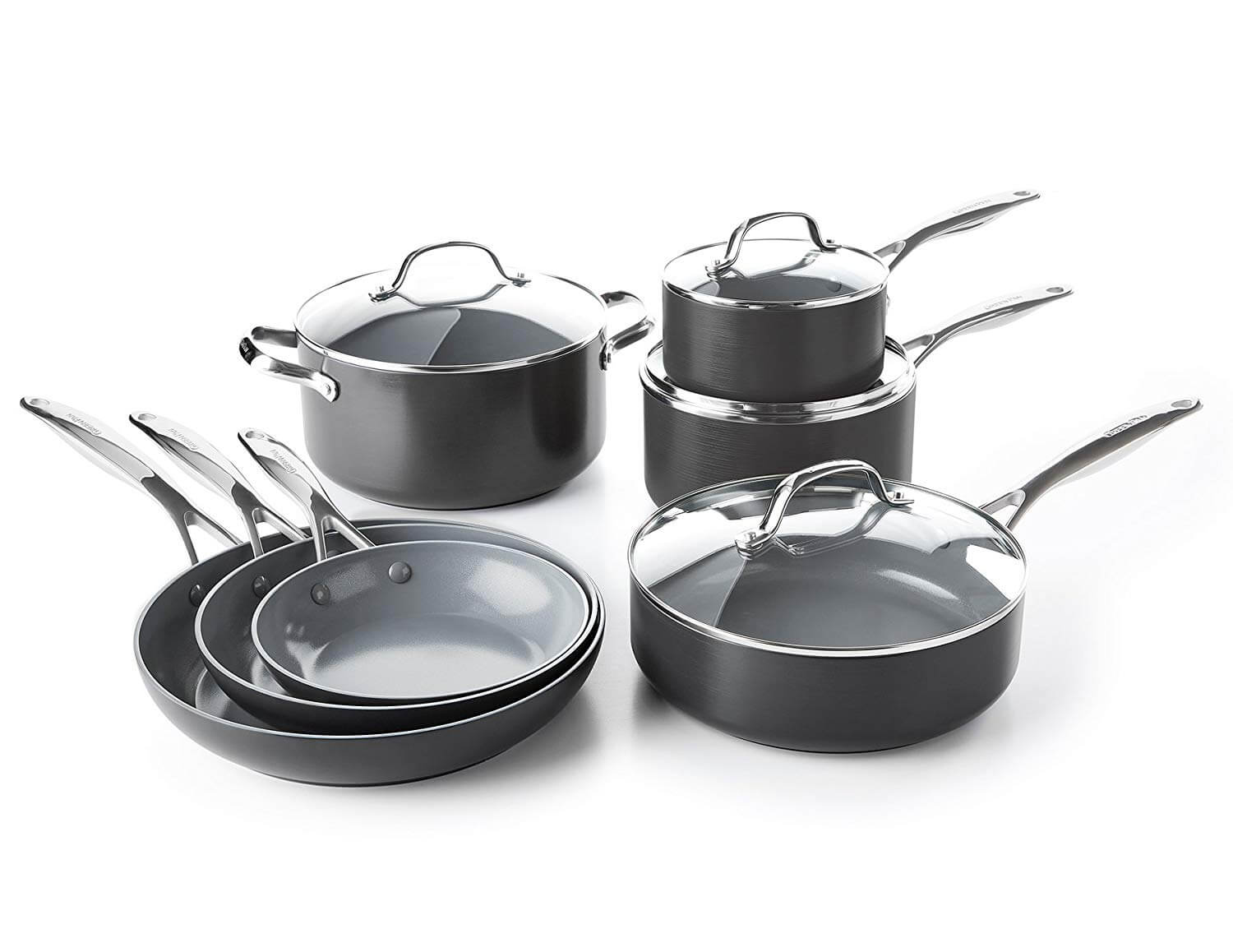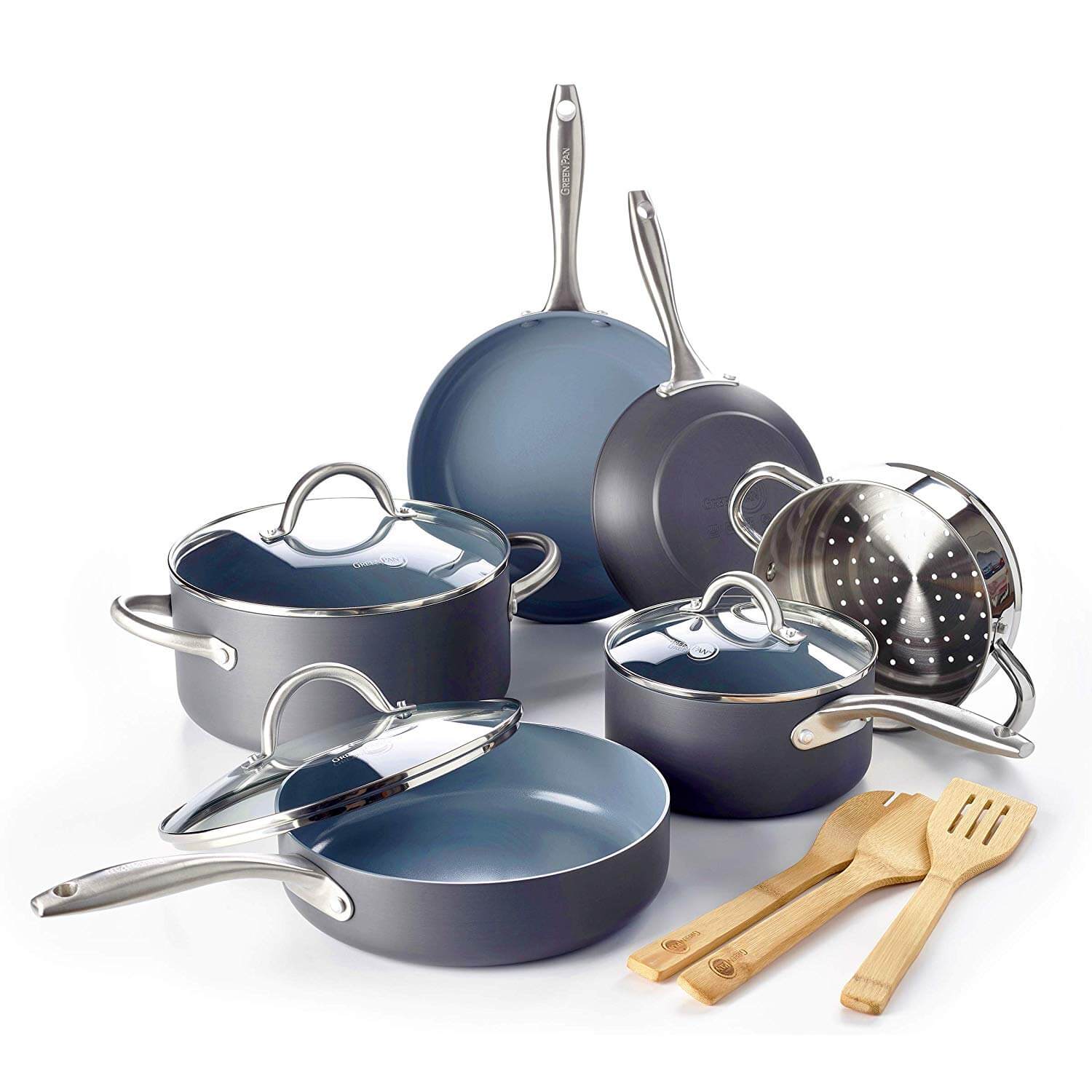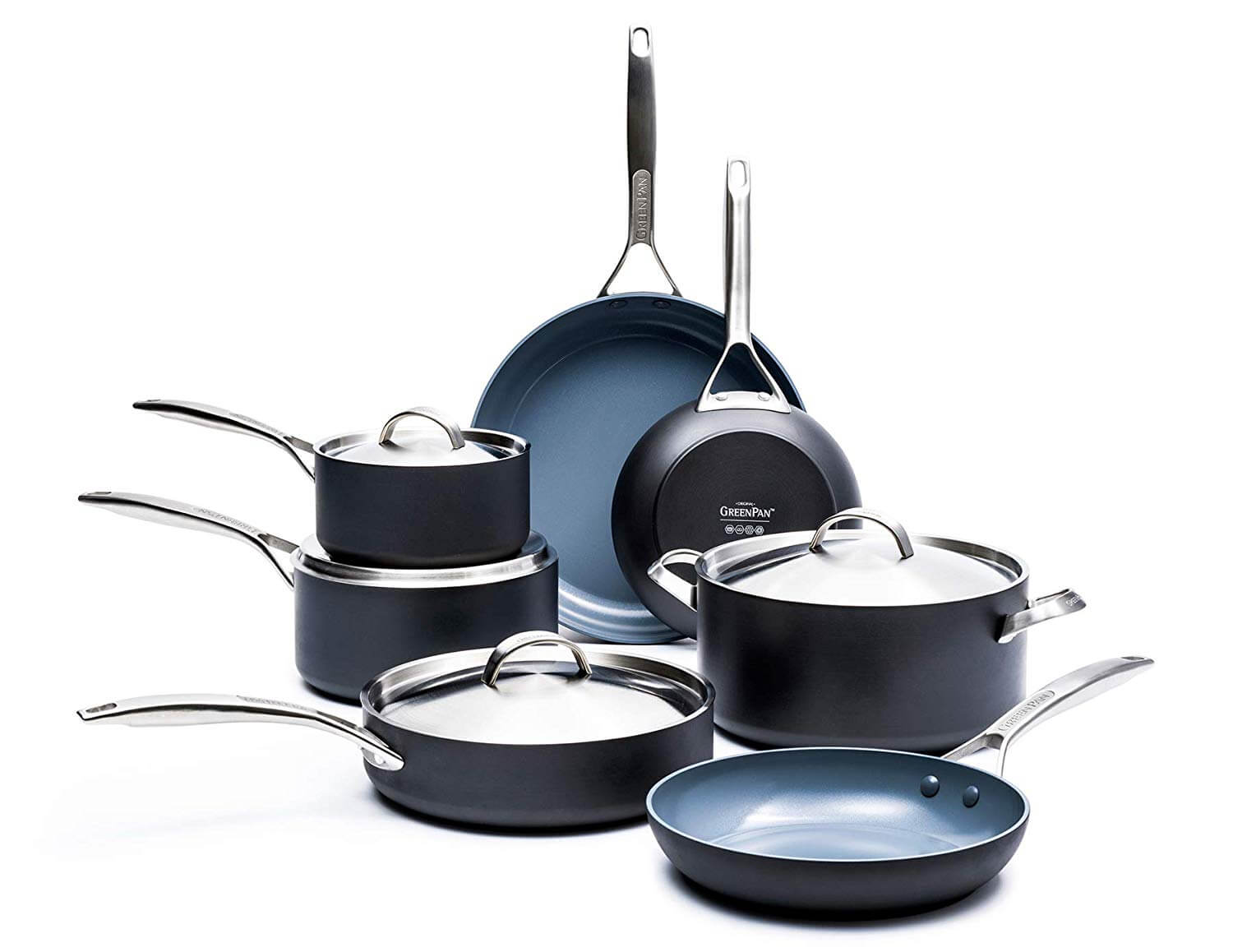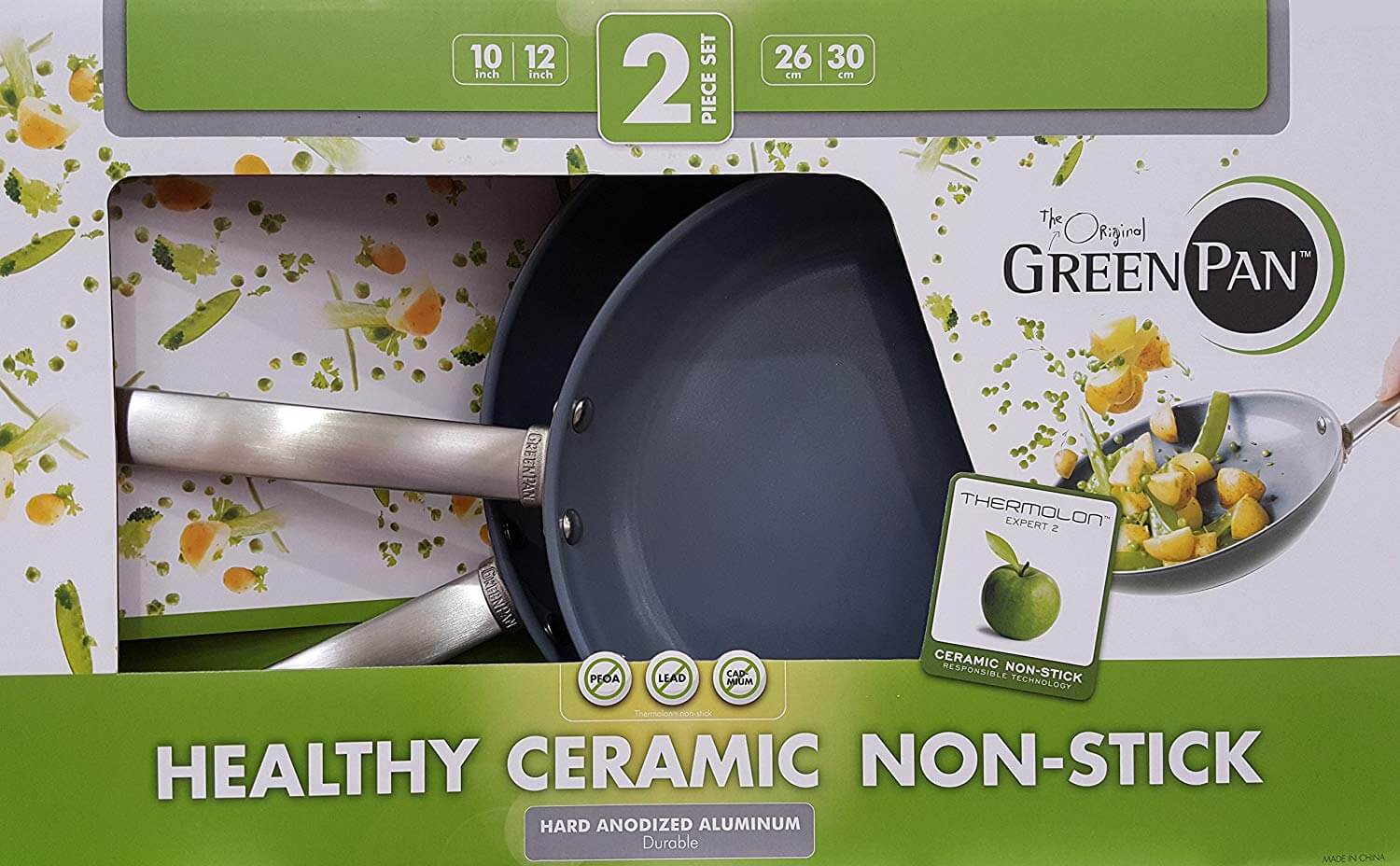If you avoid cookware coatings such as Teflon in your home, then you are probably familiar with GreenPan. The first manufacturer to move away from traditional non-stick back in 2007; GreenPan offers a range of aluminum and hard-anodized aluminum cookware with ceramic coatings which are free from PFOA, PFAS, lead and cadmium.
With aluminum and hard-anodized aluminum ranges available for different budgets, we have undertaken a number of GreenPan reviews to help you decide on the most suitable range or pan for your home. We also look at why GreenPan cookware is popular and what you can do to help keep your cookware looking and cooking at its best.Quick Comparison: Top 7 Best GreenPans
1. GreenPan Valencia Pro Gray Ceramic Cookware Set
The GreenPan Valencia Pro gray ceramic cookware set (11 piece) is suitable for all stovetops including induction, due to its Magneto induction technology. This cookware is hard-anodized aluminum with Thermolon Minerals non-stick coating which contains minerals for a more durable and resilient non-stick.
This cookware is free from PFOA, PFAS, lead and cadmium and the pans are safe for using with metal utensils. The pans are also suitable for using in the oven at temperatures of up to 600°F and are dishwasher safe, although the manufacturer recommends that you wash by hand.
The set includes a 5 quart covered casserole/Dutch oven, a 3 quart covered skillet and three frypans (8″, 9.5″ and 11″). There are also covered 2 quart and 3 quart sauce pans. There is a lifetime limited warranty on this cookware set.Pros
Cons
2. GreenPan Focus Turquoise Ceramic Cookware Set
The GreenPan Focus turquoise ceramic cookware set (12 piece) is heavy-gauge construction with a Thermolon non-stick ceramic coating. The handles are comfort-grip Bakelite and will stay cool, although there may be a higher risk of damage to the Bakelite when the cookware is in use.
This cookware comes with a lifetime limited warranty and is oven safe up to the manufacturer’s recommended temperatures. The set includes a 2 quart covered sauce pan, a 1 quart conical covered fry pan, a 10″ covered fry pan, 8″ open skillet, 5 quart covered casserole and a stainless steel steamer insert.Pros
Cons
3. GreenPan Rio Black Ceramic Cookware Set
The GreenPan Rio black ceramic cookware set (12 piece) has a superior cream inner Thermalon non-stick coating that allows you to cook with minimal oil. This cookware is manufactured without PFOA, PFAS, cadmium or lead and even if the pan is overheated, it will not release any harmful fumes. It is worth noting that the non-stick coating on these pans will begin to wear down with time, and, as acknowledged by the manufacturer, at this point the cookware will begin to work in the same way as an enameled cast iron pan.
You should follow the manufacturer’s instructions about which oils to use when cooking, extra virgin olive oil is not suitable for use in these pans due to its temperature. These pans are suitable for all stovetops except induction, the set includes 1 quart, 2 quart and 3 quart covered saucepans, a 5 quart covered casserole, a 9.5″ covered sauté pan, a 9.5″ open frypan and an 8″ open frypan. The Bakelite handles are comfort-grip and stay cool and the glass lids are oven safe up to 350°F. This set comes with a lifetime limited warranty.
Pros
Cons
4. GreenPan Lima Ceramic Cookware Set
The gray GreenPan Lima ceramic cookware set (12 piece) is hard-anodized aluminum coated with Thermolon ceramic non-stick. This cookware is oven safe, as are the glass lids, which are safe up to 420°F. The handles are riveted stainless steel and contoured for a comfort grip.
The set includes a saucepan, a Dutch oven, a covered sauté pan and two open fry pans. There is also a colander and three wooded utensils, although you may find that the edges on the utensils are rough and could damage the ceramic interior. This cookware is dishwasher safe and it comes with a lifetime limited warranty.
Like any ceramic pan, these can be liable to staining by certain foods, especially if you cook at slightly higher heat.Pros
Cons
5. GreenPan Paris Ceramic Cookware Set
The GreenPan Paris ceramic cookware set (11 piece) is a gray colored hard-anodized aluminum set with Thermolon non-stick coating. Designed for maximum scratch resistance and strength, it also offers excellent heat conduction and is safe for using with metal utensils.
The handles and lids are stainless steel and all the cookware is oven safe up to 600°F. This cookware is free from lead, cadmium, PFOA and PFAS and comes with a lifetime limited warranty. The set includes a 1.5 quart and 3 quart covered sauce pans, three open frypans (8″, 9.5″ and 11″), a covered 3 quart sauté pan and a 5.5 quart Dutch oven.
Like any ceramic cookware, you need to avoid high heat when using, and it can take time to adjust your cooking practices when using ceramic cookware.
Pros
Cons
6. GreenPan Padova Ice Blue Ceramic Cookware Set
The GreenPan Padova ice blue ceramic cookware set (11 piece) has a light blue exterior and cream ceramic interior. This is hard-anodized aluminum cookware with a Thermolon ceramic non-stick coating that is safe for using with metal utensils.
The pans are oven safe, as are the glass lids up to 420°F. This cookware is made free from cadmium, lead, PFOA or PFAS. The set is a 2 quart covered sauce pan, a 3 quart covered casserole, 2.5 quart covered skillet and 8 quart stockpot. There is also an 8″ and an 11″ open frypan. This cookware set comes with a lifetime limited warranty.
Pros
Cons
7. GreenPan Hard-Anodized Ceramic Skillets
The GreenPan hard-anodized aluminum ceramic skillets (2-piece) are a 10″ and 12″ open skillets. With the Thermolon non-stick coating, these are free from PFOA and PFAS and nor is there any lead or cadmium used in their manufacture. They have stainless steel handles that are riveted, and these skillets are also oven safe.
Use of cooking sprays is not recommended in these pans, and if you do accidently use it, there is a higher risk of food sticking. These skillets have a lifetime limited warranty.Pros
Cons
Things to Consider Before Buying GreenPan Cookware
About GreenPan
GreenPan developed in 2007 when two Belgians developed cookware without PFOA during its manufacture and which, when overheated, would not release toxins. Today’s ranges have the fifth generation of non-stick coating with the Thermalon reinforced with diamond to make it more durable.
The surfaces of the cookware use reinforced surface technology for scratch-resistance and maximum strength. Upcycled aluminum and stainless steel is used wherever possible and 60% less carbon is emitted when Thermolon is cured compared to traditional coatings.
The limited lifetime warranty on all GreenPans covers workmanship and material defects for the pan and its non-stick coating, although the warranty of the Thermalon non-stick is limited to two years for manufacturing defects.
Cooking With, and Taking Care of Ceramic Cookware
Ceramic cookware is able to conduct heat more efficiently than traditional pans which means you can cook on lower heat. If you do cook at higher heat there is a greater risk of food burning, which can be quite difficult to remove from ceramic cookware.
You need to use the lowest temperature setting that you can when cooking with ceramic, and if you do cook at a higher heat, keep it to the maximum temperature recommended by the manufacturer (usually medium heat) otherwise you may void the warranty on the cookware.
Because a ceramic coating is irregular at its molecular level, you may also find that the cookware can cook more unevenly, developing hot or cold spots during cooking. All of this means that it can take some time to get used to cooking with ceramic, especially if used to stainless steel.
Although GreenPan say there is no need to season the cookware, they do recommend use of a little butter or oil when cooking. Peanut, sunflower or coconut oils are suitable, but because oil sprays and extra virgin olive oil carbonize quickly when the pan is heated, you should avoid using these.
Silicone, wood or nylon utensils are also suitable for using with ceramic cookware; metal should be avoided as it can scratch the inner surface.
When stored, it can be helpful to keep an old cloth or towel in between pans to minimize the risk of any damage. Ceramic coatings are at more risk of chipping and scratching as the surface is more fragile than the traditional PTFE coatings such as Teflon.
Cleaning GreenPans
Pans should be cool before washing and only a soft sponge should be used to prevent any surface damage. If necessary, you can leave pans to soak overnight if heavily stained.
Although some GreenPans are suitable for cleaning in the dishwasher, the manufacturer recommends hand washing as dishwasher detergents can damage the non-stick properties of the coating.
PTFE, PFOA and PFAS
PTFE or polytetrafluoroethylene is a synthetic chemical, of which Teflon is the most well-known brand name. Although this is a stable chemical, it can begin to break down and give off fumes if overheated. These fumes can cause mild flu-like symptoms in us but can be very dangerous for pet birds in the home.
PFOA or perfluorooctanoic acid is another synthetic chemical that used in making Teflon and similar PTFE coatings. Because PFOA can stay in the environment and the body, there are concerns that it may be hazardous to our health and may contribute to our risk of cancer.
Both PTFE and PFOA belong to the group of chemicals called Per- and polyfluoroalkyl substances or PFAS. These PFAS are found in cookware and other household products such as water-repellent fabrics and cleaning products. Some food can be packed in materials that contain PFAS or even grown in soil or water contaminated with PFAS.
Because there is evidence that PFAS may have some impact upon our health, a number of PFAS are no longer made in the US as major chemical manufacturers agreed to eliminate them from their products.
Ceramic cookware does not contain any PTFE, neither is it made using PFOA, or indeed any PFAS. The ceramic coating is made from an inorganic solid, usually silicone.
Lead and Cadmium
Some ceramic glazes contain cadmium or lead which can leak into food from the cookware. This is usually as a byproduct of ceramic or ceramic coating manufacturing, rather than in the ceramic or ceramic coating itself.
The US Food and Drug Administration (FDA) requires that ceramic products in the US have less than the federal and state maximum permitted levels of leachable lead and cadmium. The FDA monitors this under federal law.
California has a ban of less than 0.1 parts of lead per million (ppm) in any foodware surface as part of its California Prop 65 or Proposition 65.
Environmental Impact and Safety of Ceramic Coatings such as Thermolon
Thermalon and similar non-stick coating are inorganic and usually made from silicon (sand). This tends to make the composition more environmentally friendly and because it often only needs one application layer during manufacture (coatings such as Teflon may need three or more applications) and requires less curing time, it does use less energy and have smaller carbon footprint.
Thermolon is usually applied to cookware through a process called Sol-gel, which converts the liquid solution into a gel that can be applied to the metal. This is then fired or cured at high heat.
Because ceramic coatings are inorganic, they tend to be heat resistant up to around 840°F. PTFE coating such as Teflon can start to break down at 500°F. Even if a ceramic coating is heated beyond its heat resistant point, it will not emit any toxic fumes.
Conclusion
With many of us choosing to avoid cookware and other products that contain PFAS or are manufactured with PFOAs, GreenPan is a leading manufacturer of cookware which is free from not just these, but also lead and cadmium. Ceramic cookware is also more environmentally friendly than traditional types of coated cookware.
There are some extra considerations for cooking with ceramic, such as using the correct type of oil, and limiting cooking temperatures, and we trust that our GreenPan reviews have been useful in highlighting these. We also hope these reviews have allowed you to choose cookware that does not just meet your cooking needs but also allows you to avoid some contaminants which may impact upon the health of you and your family.








Would like your opinion on the New York Pro line.
I would like to see a comparison with the new york line. Thanks